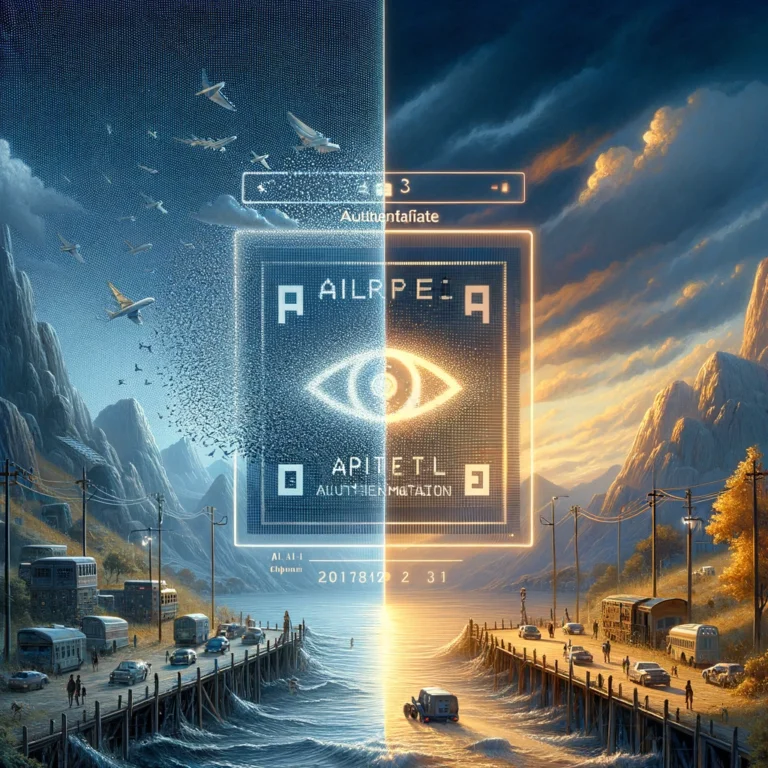Did you know that over 50% of consumers struggle to distinguish between real images and AI-generated ones? With the rise of deepfakes and manipulated visuals, the need for authenticity in digital content has become more crucial than ever. In an exciting development, OpenAI has taken a significant step towards addressing this issue. They have announced that their latest AI model, DALL-E 3, will introduce DALL-E 3 Watermarks in AI-generated images to enhance their authenticity and combat the spread of misinformation.
Enhancing Digital Authenticity with DALL-E 3 Watermarks
This move by OpenAI reflects their commitment to promote transparency and ensure responsible use of AI-generated content. By incorporating watermarks into AI-generated images, OpenAI aims to prevent confusion between real and AI-created visuals, safeguarding against the potential harmful effects of misinformation. These DALL-E 3 Watermarks will take two forms: a visible watermark placed strategically in the top left corner of the image and embedded metadata indicating the origin of the image.
The introduction of watermarks not only adds a layer of authenticity but also acts as a form of attribution, acknowledging the source and creator of the image. This step is significant in fostering ethical practices and accountability in the use of AI-generated content.
Furthermore, watermarked AI-generated images will be invaluable for research and training in fields such as image processing, computer vision, and artificial intelligence. These visuals can serve as valuable resources for academic institutions, enhancing the development and understanding of cutting-edge technologies.
Addressing Limitations and Future Directions
While the implementation of watermarks is undoubtedly a positive step towards authenticity, it’s important to acknowledge some limitations. OpenAI recognizes that watermarks can be removed or altered, and image metadata can be stripped by social media platforms and other means. However, the inclusion of visible watermarks serves as a visible indication of the image’s AI origin, acting as a deterrent against the spread of misinformation.
OpenAI’s decision to introduce watermarks for AI generated images with DALL-E 3 sets a precedent for the responsible use of this technology. As advancements continue to unfold, future considerations may involve refining watermarking techniques and implementing robust data security measures. OpenAI’s dedication to transparency and continuous improvement ensures that the landscape of AI-generated content authentication will evolve for the better.
The Benefits of DALL-E 3 Watermarked AI-Generated Images

DALL-E 3 Watermarks AI-generated images offers numerous advantages in the realm of image processing and artificial intelligence. With the rise of neural networks and generative models, the ability to generate realistic images has become increasingly attainable. However, to ensure the responsible use of such technology, the integration of watermarks provides crucial benefits for both creators and consumers.
Promoting Authenticity and Reducing Misinformation
By applying DALL-E 3 Watermarks to AI-generated images, clear identification is achieved, distinguishing them from real images. In an era plagued by deepfakes and manipulated visuals, this differentiation is essential in maintaining trust and preventing the spread of misinformation. Watermarks become a powerful tool to combat the potential harm caused by misleading images, protecting individuals and organizations from the negative consequences of image manipulation.
Acknowledging Attribution and Encouraging Ethical Practices
Watermarks serve as a form of attribution, allowing the original source and creator of the AI-generated image to be acknowledged. This inherent transparency fosters ethical practices in image creation and usage. It provides a means for artists, researchers, and content creators to rightly claim ownership of their work, promoting respect for intellectual property rights and establishing best practices within the evolving landscape of AI-generated content.
Facilitating Research and Advancements in Computer Vision
Watermarked AI-generated images contribute significantly to the domains of image processing, deep learning, and computer vision. By making these images readily available, researchers and scientists can leverage large datasets to develop more robust algorithms, train neural networks, and advance artificial intelligence technologies. The integration of watermarks ensures that these images can be reliably identified and utilized in various experiments, studies, and innovations.
DALL-E 3 Watermarking AI-generated images not only enhances authenticity and attribution but also fuels the progress of image recognition and computer vision technologies.
The responsible use of watermarked AI-generated images establishes a secure foundation for further developments and breakthroughs in the field of artificial intelligence. As researchers explore the vast potential of generative models and neural networks, the presence of watermarks adds a layer of accountability and integrity, reinforcing the importance of accurate image attribution and data transparency.
Through these key benefits, the integration of watermarks in AI-generated images champions responsible practices, safeguards against misinformation, and propels advancements in image processing, computer vision, and artificial intelligence.
Limitations and Future Considerations
While watermarks play a crucial role in enhancing the authenticity of AI-generated images, it’s essential to recognize their limitations. OpenAI acknowledges that watermarks can be easily removed, whether intentionally or accidentally, and that image metadata can be stripped by various platforms, including social media platforms. Despite these limitations, the inclusion of watermarks serves as a visible indication of an image’s AI origin and acts as a deterrent against the spread of misinformation.
OpenAI has stated that initial implementation will focus on images, with AI-generated videos and audios not currently included in the watermarking process. However, as technology continues to evolve, it is foreseeable that advancements in watermarking techniques and data security measures will address these limitations.
The Collaborative Content Attribution Protocol (C2PA), a coalition between Adobe, Microsoft, the BBC, and other industry leaders, is actively working on developing innovative solutions to enhance the security and authenticity of digital content. This collaborative effort aims to build a universal standard for incorporating image metadata, including AI-generated media, across various social media platforms. By implementing standardized metadata, platforms can more effectively recognize and handle AI-generated images and videos, thus minimizing the risk of misinformation spreading unchecked.
As the importance of data security becomes increasingly apparent, it is crucial to prioritize the protection of AI-generated content. The integration of robust data security measures, such as secure storage, encryption, and authentication methods, will play a pivotal role in ensuring the integrity and authenticity of AI-generated media. OpenAI’s commitment to transparency and continuous improvement sets the stage for future developments in AI-generated content authentication, contributing to a more secure and trustworthy digital landscape.






